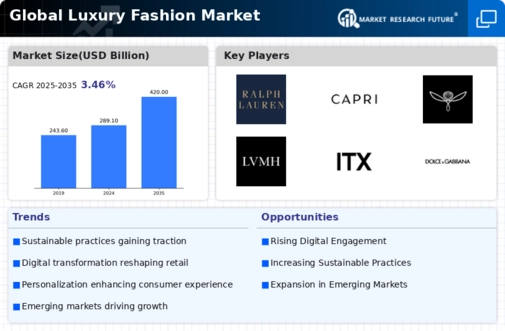E-commerce Expansion
The rapid expansion of e-commerce platforms is reshaping the Global Luxury Fashion Market Industry. Online retailing provides luxury brands with an opportunity to reach a broader audience, transcending geographical limitations. Major luxury fashion houses are increasingly investing in their digital presence, enhancing user experience through personalized services and exclusive online collections. This shift not only caters to the tech-savvy consumer but also aligns with the growing trend of convenience shopping. As a result, e-commerce is expected to contribute significantly to the market's growth trajectory, facilitating access to luxury products and potentially increasing overall sales.
Sustainability Trends
Sustainability has emerged as a pivotal driver within the Global Luxury Fashion Market Industry, as consumers increasingly prioritize ethical and environmentally friendly practices. Luxury brands are responding by adopting sustainable sourcing, eco-friendly materials, and transparent supply chains. This shift is not merely a trend but appears to be a fundamental change in consumer expectations. Brands that successfully integrate sustainability into their business models may gain a competitive edge, appealing to a conscientious consumer base. The emphasis on sustainability is likely to influence purchasing decisions, thereby shaping the future landscape of luxury fashion.
Rising Disposable Income
The Global Luxury Fashion Market Industry appears to be significantly influenced by the rising disposable income among consumers, particularly in emerging economies. As individuals experience increased financial freedom, their propensity to spend on luxury goods escalates. For instance, in regions such as Asia-Pacific, the burgeoning middle class is projected to drive demand for high-end fashion items. This trend is reflected in the market's expected growth to 289.1 USD Billion in 2024, with a potential increase to 420.0 USD Billion by 2035, indicating a robust CAGR of 3.46% from 2025 to 2035.
Influence of Social Media
The influence of social media on the Global Luxury Fashion Market Industry cannot be understated. Platforms such as Instagram and TikTok serve as powerful marketing tools, enabling brands to engage with consumers in innovative ways. Influencers and celebrities often showcase luxury items, creating aspirational lifestyles that resonate with followers. This digital word-of-mouth marketing fosters brand loyalty and drives sales, particularly among younger demographics. As social media continues to evolve, its role in shaping consumer perceptions and preferences in luxury fashion is likely to expand, further driving market growth.
Market Growth Projections
The Global Luxury Fashion Market Industry is projected to experience substantial growth, with estimates indicating a rise from 289.1 USD Billion in 2024 to 420.0 USD Billion by 2035. This trajectory suggests a compound annual growth rate of 3.46% from 2025 to 2035, reflecting a sustained demand for luxury goods. The market's expansion is likely driven by various factors, including increased consumer spending, the rise of e-commerce, and the growing influence of social media. As brands adapt to changing consumer preferences and market dynamics, the luxury fashion sector appears poised for continued evolution and growth.
Globalization of Fashion Trends
The globalization of fashion trends plays a crucial role in the Global Luxury Fashion Market Industry. As cultural boundaries blur, consumers gain access to diverse styles and influences from around the world. This interconnectedness fosters a demand for luxury items that reflect a blend of global aesthetics. Brands that successfully navigate this landscape can capitalize on the desire for unique, culturally rich products. The ongoing exchange of ideas and trends across borders is expected to enhance the appeal of luxury fashion, potentially driving market expansion and increasing brand visibility on a global scale.


















Leave a Comment